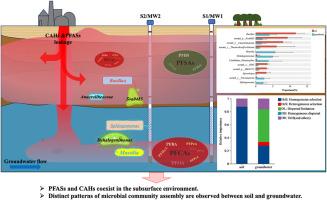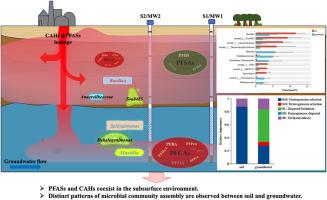Effects of concurrent PFASs and CAHs on microbial communities in soil and groundwater: an insight for their ecological niches and implications for bioremediation
IF 7.3
2区 环境科学与生态学
Q1 ENVIRONMENTAL SCIENCES
引用次数: 0
Abstract
The combined impacts of per- and polyfluoroalkyl substances (PFASs) and chlorinated aliphatic hydrocarbons (CAHs) on native microbial communities in subsurface remain poorly understood. In this study, we employed high-throughput sequencing to investigate the impacts of concurrent PFASs and CAHs on the indigenous microbial communities in soil and groundwater. Additionally, we assessed the relative contributions of deterministic and stochastic processes in shaping microbial community assembly across these two subsurface compartments. The results revealed that perfluorooctanoic acid was the dominant PFAS compound in subsurface, and short-chain perfluorocarboxylic acids (C < 8) were prevalent in groundwater, while perfluorosulfonic acids were more likely retained in soil. CAHs were detected at concentrations up to 650.15 mg/L in groundwater, suggesting the presence of dense non-aqueous-phase liquids in subsurface. The comparative analysis on the microbial diversity and compositions showed that microbial diversity in groundwater was more influenced by the distribution of contaminants compared to that in soil. Additionally, the βNTI analysis results indicated that microbial community assembly in soil was mainly shaped by homogeneous selection, whereas stochastic processes dominated the evolution of microbial community in groundwater. Furthermore, anaerobic fermentative taxa species such as Bacillus and Sva0485 dominated in soil, while aerobic pollutant-degrading taxa like Oxalobacteraceae and Dehalogenimonas were enriched in groundwater. These findings highlight the need to consider microbial communities and ecological processes when designing effective in-situ bioremediation strategies.


PFASs和CAHs对土壤和地下水微生物群落的影响:生态位及其生物修复意义
全氟烷基和多氟烷基物质(PFASs)以及氯化脂肪烃(CAHs)对地下原生微生物群落的综合影响仍然知之甚少。在这项研究中,我们采用高通量测序方法研究了PFASs和CAHs同时存在对土壤和地下水中本地微生物群落的影响。此外,我们评估了确定性和随机过程在形成这两个地下隔间的微生物群落组装中的相对贡献。结果表明,全氟辛酸是地下水中主要的PFAS化合物,地下水中多为短链全氟羧酸(C<8),土壤中多为全氟磺酸。地下水中检测到的CAHs浓度高达650.15 mg/L,表明地下存在致密的非水相液体。微生物多样性和组成对比分析表明,地下水微生物多样性受污染物分布的影响大于土壤微生物多样性。此外,βNTI分析结果表明,土壤中微生物群落的形成主要是均匀选择,而地下水中微生物群落的演变主要是随机过程。土壤中以Bacillus和Sva0485等厌氧发酵类群为主,地下水中以Oxalobacteraceae和Dehalogenimonas等好氧降解污染物类群为主。这些发现强调了在设计有效的原位生物修复策略时需要考虑微生物群落和生态过程。
本文章由计算机程序翻译,如有差异,请以英文原文为准。
求助全文
约1分钟内获得全文
求助全文
来源期刊

Environmental Pollution
环境科学-环境科学
CiteScore
16.00
自引率
6.70%
发文量
2082
审稿时长
2.9 months
期刊介绍:
Environmental Pollution is an international peer-reviewed journal that publishes high-quality research papers and review articles covering all aspects of environmental pollution and its impacts on ecosystems and human health.
Subject areas include, but are not limited to:
• Sources and occurrences of pollutants that are clearly defined and measured in environmental compartments, food and food-related items, and human bodies;
• Interlinks between contaminant exposure and biological, ecological, and human health effects, including those of climate change;
• Contaminants of emerging concerns (including but not limited to antibiotic resistant microorganisms or genes, microplastics/nanoplastics, electronic wastes, light, and noise) and/or their biological, ecological, or human health effects;
• Laboratory and field studies on the remediation/mitigation of environmental pollution via new techniques and with clear links to biological, ecological, or human health effects;
• Modeling of pollution processes, patterns, or trends that is of clear environmental and/or human health interest;
• New techniques that measure and examine environmental occurrences, transport, behavior, and effects of pollutants within the environment or the laboratory, provided that they can be clearly used to address problems within regional or global environmental compartments.
 求助内容:
求助内容: 应助结果提醒方式:
应助结果提醒方式:


